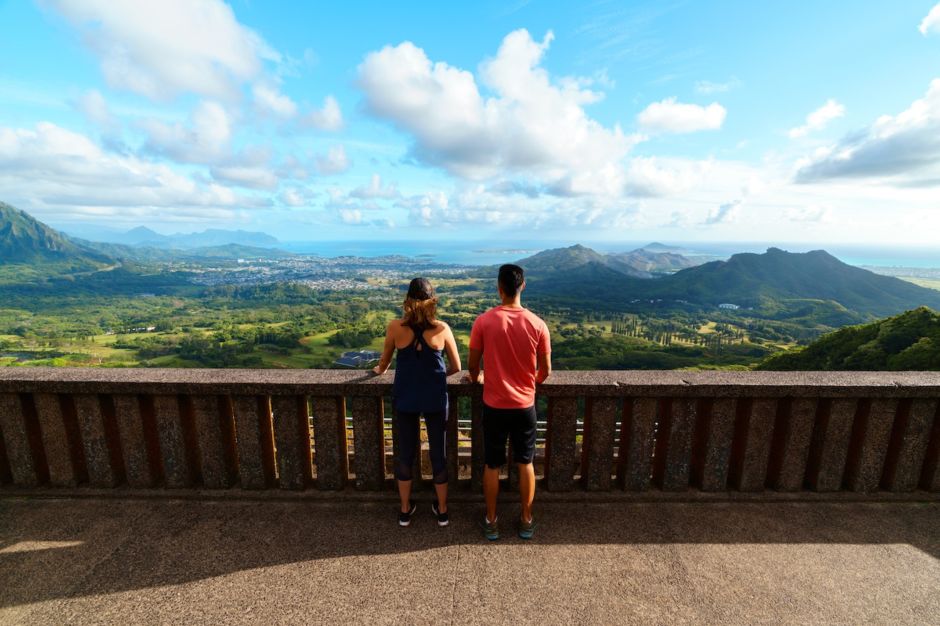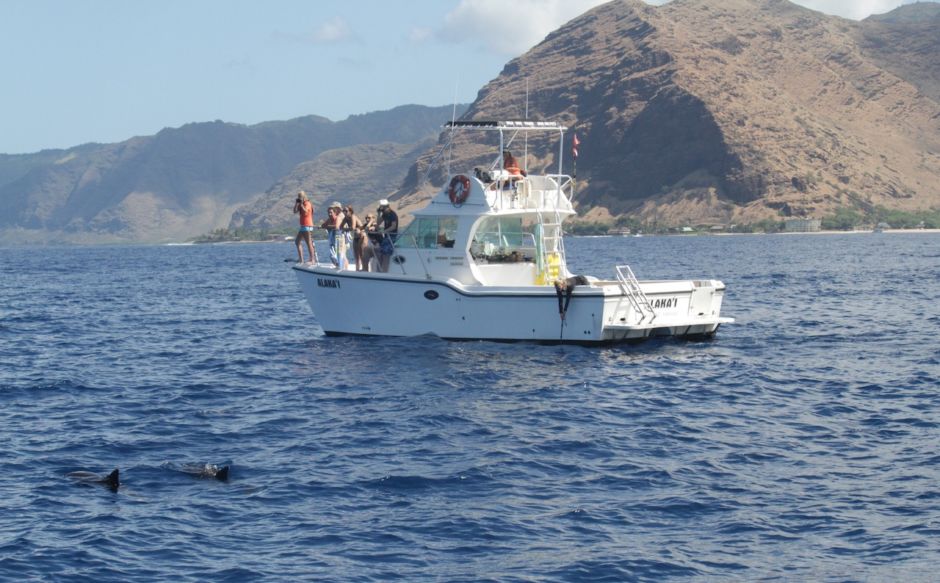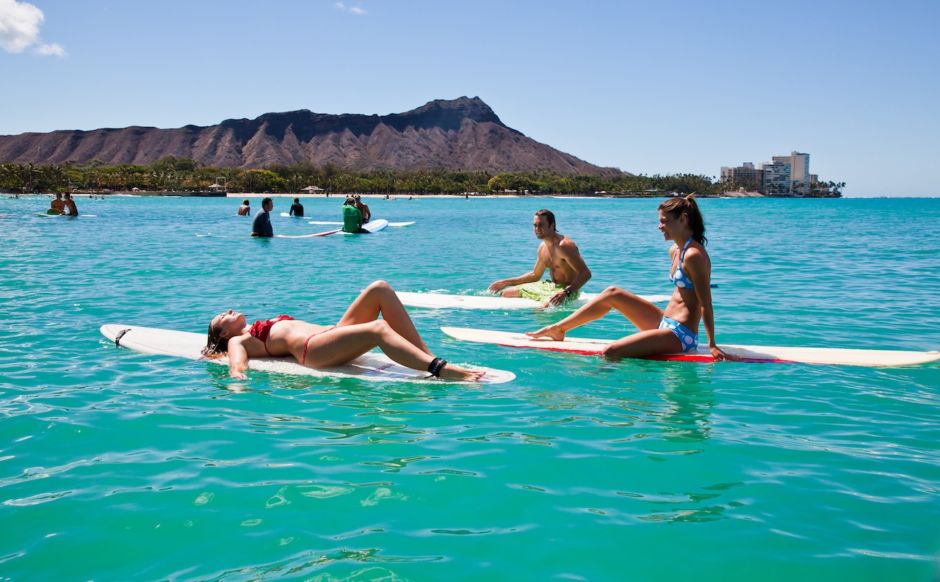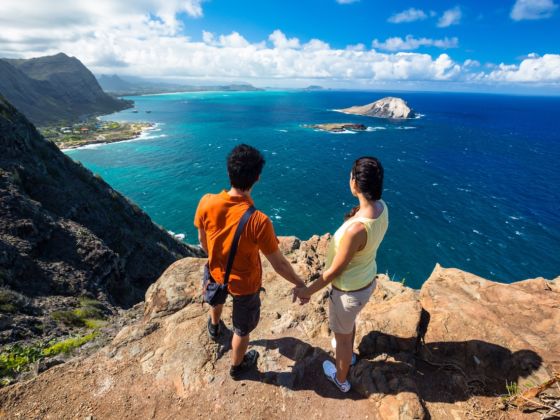The Hawaiian Islands are some of the most isolated in the Pacific, meaning they’ve had eons to grow their own delicate ecosystem that only gets more fragile as technology churns and burns onward.
Oahu — home to Honolulu, Waikiki, and two-thirds of the state’s population — is only 44 miles long and 30 miles wide. Every inch of these hills, mountains, and valleys is precious. The tour and travel experiences below are sustainable, low-footprint ways to celebrate the land and sea, for kamaaina (locals) and malihini (visitors) alike.
KA AINA – LAND

Photo: Hawaii Tourism Authority/Blake Bronstad
“Private property” wasn’t a thing for Hawaiians back in the day. As you explore the island, go in with that mindset — the land is for all of us and none of us. Respect it, and it will give back. Here are a few sustainable activities to consider:
Horseback riding at Gunstock Ranch
The former sugar mill town of Kahuku is home to Gunstock Ranch, a real working ranch where guests can try on the paniolo (cowboy) life. The private, guided horseback rides wind along mountain trails, with views of the lush Koolau Mountain Range and the Pacific not too far away. On the way back, you’ll select, dedicate, and plant your very own tree in the Hawaiian Legacy Forest, where it will continue to grow for generations.
Hiking to and through organic farms
The Farm to Forest Tour with Hawaii Forest & Trail starts at the beach on Oahu’s west side and travels up to the forested mountains overlooking the ocean. The eight-hour excursion — long but still family-friendly — includes access to the Palehua hike in Kapolei, a restricted area that’s home to native Hawaiian flora and fauna you’ll be hard-pressed to find on public hiking trails. You’ll also visit MAO Organic Farms, which grows fresh food for locals, but also gives back to the community by helping its interns pay for college.
Tasting Hawaii farm-to-table
The biodynamic and sustainable farming practices at Kahumana Organic Farm & Cafe are geared towards reducing the island’s dependence on importing food. Kahumana also develops social programs that aid vulnerable members of the West Oahu community, offering transitional housing for homeless families, a day program for adults with developmental disabilities, and daycare and school programs for at-risk youth. Schedule a farm-to-table experience to tour the farm before enjoying a meal at their cafe.
Appreciating taro
Up on the North Shore, Waialua’s Na Mea Kupono Taro Farm is a traditional loi kalo (taro patch). Taro, a staple in the native Hawaiian diet “staff of life,” is grown here via the wetland method: Rainwater falls on the mountains, seeps into the land, and emerges in an artesian well. The taro is farmed within this water and then harvested, and you’ll see just how on your visit. Its leaves and root are cooked to make different dishes, the most important being poi, a starchy paste central to native culture.

Photo: Hawaii Tourism Authority/John Hook
Going for a tasting at Manulele Distillers
In the westside town of Kunia, fields of sugarcane have replaced the old Dole plantation pineapple fields. These surround Manulele Distillers, where you should definitely stop in for a tasting. Sugarcane (ko in Hawaiian) has been a part of the island’s history for over 1,000 years — way before the days of the plantations — and was prized in traditional medicine. While most of the world’s rum is made from molasses (a byproduct of industrial sugar manufacturing), Manulele cultivates their own specially selected heirloom varietals to press and distill its small-batch, farm-to-bottle Ko Hana Rum.
Getting an intimate look at the capital’s art scene
There’s no better guide to Honolulu’s hip Kakaako neighborhood than husband-and-wife duo Matt and Roxy Ortiz, the creative force behind Wooden Wave. Their work centers on hand-drawn illustrations and paintings with sustainable treehouses as a frequent theme. They offer a guided tour of the murals in the city’s street art district — including one of their own pieces — and a behind-the-scenes look at the creative collective at Lana Lane Studios. (Book the Wooden Wave tour, as well as other art experiences, via the Art World Escape app.)
Stopping at SALT for local everything
Named after the salt ponds that once existed in the area, SALT at Our Kaka‘ako is a curated retail center focused on local culture, food, shopping, and community. Taste traditional Hawaiian laulau (pork, fish, or chicken wrapped in taro leaves and steamed) or pipikaula (salted, dried beef) at the family-owned Highway Inn; sample handcrafted cocktails and the always-seasonal menu at Moku Kitchen; dine on locally sourced seafood at FISH; take a cheesemaking class with Naked Cow Dairy Farm & Creamery; or pick up some Lonohana Estate chocolate, made in Hawaii from bean to bar.
KE KAI – SEA

Photo: Wild Side Specialty Tours
The boundaries of the state of Hawaii encompass roughly 4,500 square miles of the Pacific, and you can bet these waters are just as valued — and revered — as any stretch of land. Here’s what you might find yourself doing on the water around Oahu:
Getting closer to wildlife
Explore Hawaii marine life with Wild Side Specialty Tours in Waianae, where small groups get to swim with dolphins, snorkel through turtle reefs, and go whale-watching all year round. The organization is founded and led by marine biologists, and you’ll learn a lot while also giving back — a portion of the proceeds from each charter goes towards ocean conservation via the Wild Dolphin Foundation.
Diving with the sharks
Mano (that’s Hawaiian for shark) are held in high regard by many generations of Hawaiians as aumakua, ancestral guardians that manifest as animals. You can get a closer look at these often misunderstood creatures with One Ocean Diving, an organization dedicated to ocean conservation and behavioral research. You’ll earn some bragging rights by swimming with sharks — mostly Galapagos with the occasional tiger shark sighting — and other marine life, including turtles and dolphins. And did we mention you’ll be doing it without a cage?
Building the kids’ ocean confidence
Bring the kids to an ocean clinic by Nā Kama Kai, an organization dedicated to connecting children (ages 2-18) with the water. Founder Duane DeSoto’s mission is to teach children about ocean safety and kuleana (responsibility) through interaction with lifeguards, surfers, and other ocean professionals — and to hopefully raise a generation that feels a connection and responsibility to the land and sea.

Photo: Hawaii Tourism Authority/Tor Johnson
Longboarding on Waikiki
For an every-generation surf experience, sign up for longboarding lessons with Moniz Family Surf on world-famous Waikiki Beach. The outfit is run by Tony and Tammy Moniz and their five kids (all prolific surfers). Small groups of four will be led through a land demonstration and safety instruction, and then you’ll paddle out together into Waikiki Bay to hone your skills. If you’ve ever dreamed of riding a wave against the backdrop of Leahi (Diamond Head) crater and the famous Royal Hawaiian Hotel, your chance is here and now.

